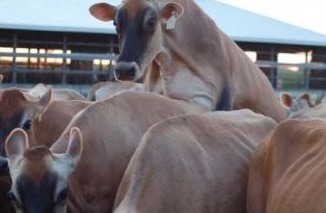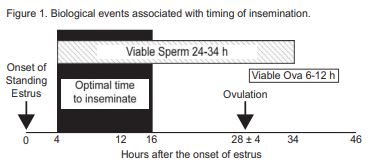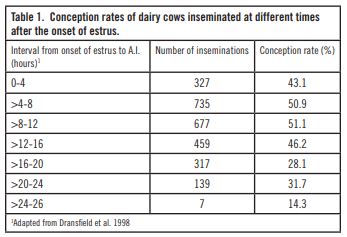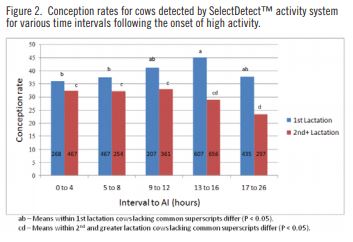What Percentage of Beef Cattle Is Through Ai
 Detection of estrus (heat) is often cited as the most costly component and undoubtedly, the major limiting factor to the success of A.I. programs on many dairy farms. Incorrect detection of estrus is related to loss of income due to extended calving intervals, milk loss, increased veterinary cost, increased heifer rearing cost, and slowed genetic progress. To achieve excellent heat detection, many factors have to be taken into account. First, the cow must express behavior and physiological changes, and secondly, these changes must be detected to determine if and when insemination should occur. It is clear that an excellent rate of heat detection is vitally important. Some herds have exceptional fertility while others struggle with conception rates, calving intervals, pregnancy rates and other parameters, which might be caused by inefficient heat detection. Numerous factors, environmental, managerial, and cow-related, play a role in estrus expression and detection. Many devices are commercially available to assist with heat detection and each producer must decide which works the best in their dairy. The time of ovulation and age of the egg at sperm penetration is critical for conception, so the goal of a heat detection program should not merely be to attain a high detection rate but to achieve a high detection rate with a corresponding high conception rate.
Detection of estrus (heat) is often cited as the most costly component and undoubtedly, the major limiting factor to the success of A.I. programs on many dairy farms. Incorrect detection of estrus is related to loss of income due to extended calving intervals, milk loss, increased veterinary cost, increased heifer rearing cost, and slowed genetic progress. To achieve excellent heat detection, many factors have to be taken into account. First, the cow must express behavior and physiological changes, and secondly, these changes must be detected to determine if and when insemination should occur. It is clear that an excellent rate of heat detection is vitally important. Some herds have exceptional fertility while others struggle with conception rates, calving intervals, pregnancy rates and other parameters, which might be caused by inefficient heat detection. Numerous factors, environmental, managerial, and cow-related, play a role in estrus expression and detection. Many devices are commercially available to assist with heat detection and each producer must decide which works the best in their dairy. The time of ovulation and age of the egg at sperm penetration is critical for conception, so the goal of a heat detection program should not merely be to attain a high detection rate but to achieve a high detection rate with a corresponding high conception rate.
BEHAVIORAL CHANGES
The occurrence of estrus is due to specific influences of ovarian steroid hormones on behavioral centers in the brain. As a growing follicle matures under the stimulation of follicle-stimulating and luteinizing hormones (FSH and LH) during the last three to four days of the estrous cycle, it synthesizes and secretes increasing quantities of estradiol. A threshold level of estradiol is reached which triggers two closely linked events – the behavioral response known as estrus and a surge of pituitary hormones, primarily LH.
It is useful to point out that the maturity of the Graafian follicle that regulates the amount of estradiol synthesized regulates its own time of ovulation and concurrent maturation of the oocyte. Traditionally, the cow that stands still and allows others to mount her is in "standing heat." Standing is the primary sign of estrus. Ovulation usually occurs approximately 24 to 32 hours after the onset of standing estrus in dairy cows. After ovulation, there is only a short period when ova can be fertilized (Figure 1). Optimal fertility of ova is projected to be between six and 12 hours after ovulation. The viable life span of sperm in the reproductive tract is estimated at 24 to 34 hours.

The average period of "standing heat" is usually less than 10 hours and consists of about one standing event per hour. Secondary signs of heat may be an indication that the cow may soon display standing estrus, is currently in estrus, or has already gone out of standing heat. Since the degree of these advanced signs vary in length and intensity, a combination or having multiple secondary signs increases the reliability of the decision to breed. It can also help to increase the amount of cows submitted to A.I. by allowing the insemination of cows that cannot be detected otherwise. Secondary signs are caused by elevated levels of estrogen on the day the animal is in heat. They are also most likely caused by estrus-related activities and events. The primary sign of estrus is a cow standing to be mounted by another cow(s) even though she could have resisted the mounting activity. The reason why secondary signs of estrus get this name is they can also be caused by events other than estrus and are secondary to standing to be mounted as the definitive sign. Therefore, a single secondary sign of estrus should not be enough to make the decision to inseminate; if a cow is not seen standing to be mounted and is suspected in estrus, it will be necessary to have a combination of secondary signs to confirm that the cow is really in estrus. Below are some of the most commonly recognized secondary signs of estrus.
• Rubbed marks – When a cow dismounts another, she slides down her tail head and rump. Therefore she puts considerable pressure on the pin bones and backbone, and this repeated abrasive action pulls out hair and may produce red, bloody or swollen sores. Size, appearance, and freshness of these marks along with the fact that few other events can cause similar signs; these rubbed marks are one of the most reliable secondary indicators of estrus. Additionally, you may find that the flanks of the cow in question have dirt or manure marks from the hooves of other cows riding them and are another indication that riding events have recently happened.
• Mucus – Many technicians would state that mucus is the most liked secondary sign of estrus. Experienced inseminators put a profound credence on this sign when deciding to breed or not to breed a cow, and sometimes they even massage the cervix and anterior vagina to express a mucus discharge. Discharged mucus dries quickly so finding dried mucus on the tail, flanks, or legs is just as good a secondary sign as seeing a string of clear viscous mucus coming from the vulva.
• Sweaty appearance – Some cows will develop a sweaty appearance when in estrus. This "wet" appearance, even though it is easily detected, is frequently overlooked and may be where the slang term "hot" cow originated.
• Swollen vulva – Rapidly growing follicles produce high circulating levels of the hormone estrogen that increase blood flow to the reproductive tract. The vulva increases in size and takes on a pinkish swollen appearance. Upon opening the labia an intense dark pink to red and highly moistened vagina is present if the cow is in estrus. In contrast, the vagina will appear dry and pale to white in color when the cow is not in estrus.
• Chin resting – Chin resting is thought to be testing by herd mates to determine if an individual is receptive to being mounted. This testing is performed by first resting a chin on the back of the cow. Considerable salivating and licking usually takes place during this testing process so you should inspect the loin and tail head area for saliva.
• Bellowing and urination – There is a tendency for increased urination. The cow will begin holding her ears erect, become restless and nervous. Cows coming into heat will become more active and will spend more time walking around rather than lying down chewing their cud. Be aware that during movement, like to and from the milking parlor, is an ideal time for a cow to mount another and therefore a great time to detect mounting activity. Some cows may appear to be standing when in fact they just couldn't get away because of crowding. Extra care should be taken to avoid false positives like this one.
• Bloody discharge – A streak of blood in the mucus usually means that that cow had a high peak of estrogen one to three days ago. It is therefore recommended to record that heat and date it two days ago. This only indicates that she has been in heat. It has no relationship with timing of ovulation or whether or not she conceived.
• Grouping – Cows in heat tend to look for willing partners to get involved in estrus-related activities. These sexually active groups are a clear indication that at least one cow inside one of these groups is in estrus.
FACTORS THAT INFLUENCE DETECTION
Cow factors
• Heritability – The heritability of estrus expression is very low and varies between cows, even for the same cow, from one estrus period to another. Just because a cow is very active today does not mean she will be at her next estrus period during this lactation or in subsequent lactations. However, there are differences between breeds. In general, Jersey cows and heifers have more intense and longer periods of estrus expression than Holstein cattle.
• Days in milk – Silent heat (more correctly, silent ovulation), is common at the first ovulation after calving. Progesterone released from the corpus luteum (CL), formed after the silent ovulation, appears to favor estrus expression during the next cycle.
• Lactation number – A report from Spain in 2006 revealed a 21 percent decrease in walking activity with each additional lactation. A study from the United Kingdom in 2009 reported a significant increase in walking activity during estrus for heifers versus first lactation cows, and a significant decrease between first and later lactations, but no difference in walking activity during estrus for cows between second and later lactations.
• Milk production – There is no correlation between estrus expression and milk yield; however, the metabolic clearance of steroid hormones related to high milk production probably reduces behavioral expression of estrus. In a study with 267 lactating dairy cows, cows with daily milk yield greater than 57 lbs. (39.5 kg) per day had lower blood estrogen levels and shorter duration of estrus than herdmates producing less than 87 lbs. (39.5 kg) of milk daily.
• Lameness – Lameness is classically associated with a reduction of estrus intensity. Lame cows spent more time lying and less time standing and walking during estrus. One study reported an overall reduction of approximately 37 percent in estrus intensity for lame cows.
• Hormonal treatments – Progesterone increases the sensitivity to estrogen and usually results in increased estrus expression, specifically mounts, chin resting, and sniffing (which may explain why after removing a CIDR® insert, increased estrus expression is common). In contrast, Gonadotropin-releasing hormone (GnRH) reduces or suppresses the expression of estrus by causing the early ovulation of the developing follicle prior to peak estrogen levels that prompt the expression of estrus.
Environmental factors
• Season – Most studies have reported a depression in estrus expression during extreme temperatures, either hot or cold. The inability to have a period of recovery from high temperatures during the day has also been reported to negatively affect estrus behavior. Heavy rain, strong wind, and high humidity also reduce or suppress estrus behavior.
• Nutrition – Loss of body reserves (negative energy balance) can negatively affect estrus expression. The presence of mycotoxins, especially vomitoxin and zearalenone, reduce or suppress estrus expression.
• Housing – The type of floor surface affects estrus behavior. Duration of estrus and number of mounts were longer (13.8 versus 9.4 hours) and greater (7 versus 3.2 times) on dirt than on concrete surfaces. Covering a concrete grooved floor with perforated rubber mats improved the ability of cows to express normal behavior activity.
• Herd size and over-crowding – The number of social interactions between cows is greater when the herd size is larger. However, over-crowding will reduce expression of estrus by limiting the space available for socially active groups to form and interact. The degree of estrus expression and therefore, the possibility of detection, can be dramatically favored by the number of cows in estrus simultaneously. This is the reason PGF injections work to increase detection, especially prior to first insemination. Each additional cow in heat at the same time has been associated with a six percent increase in walking activity.
Records
A good record keeping system is one of the most valuable tools in any detection program, mostly because it will increase the accuracy of your decisions. All heats must be recorded even if the cow is not bred at that heat. The pivotal question is when the last insemination occurred. Having an interval of 18 to 24 days makes the decision to inseminate easier. Breedings that occur with an estrus interval of four to 16 days usually result in less than desired conception rates and should be avoided unless the secondary signs strongly sway the decision to inseminate. Also knowing if the previous breeding was a result of timed A.I. or from a standing event may alter the decision. These off-cycle cows could be palpated for the presence of a clear stringy mucous as the final and definitive secondary sign to confirm the decision to inseminate.
TIMING OF INSEMINATION RELATIVE TO ESTRUS
For the past 65 years, researchers have investigated the optimal time at which to inseminate cows relative to the stage of estrus.  Trimberger (1948) found that conception rates were highest when cows were inseminated between six and 24 hours before ovulation. This early work led to the establishment of the a.m./p.m. recommendation. This guideline suggests that cows in estrus during a.m. hours should be inseminated during the pm hours, and cows in estrus in the p.m. should be bred the following a.m. However, research with large numbers of cows indicates that maximum conception rates may not be achieved using the a.m./p.m. recommendation. A large field trial (44,707 cows) found no difference in the percentage of non-return rates at 150 and 180 days (which would indicate pregnancy) between cows bred either the same morning as observed estrus, between noon and 6 p.m. on the day of observed estrus, or cows bred the following morning after observed estrus the previous evening. This indicates that a single mid-morning insemination for all cows observed in estrus the night before or the same morning should yield acceptable conception. Also, cows bred once daily (between 8 a.m. and 11 a.m.) had similar non-return rates as cows bred according to the am/pm guideline. When knowing the onset of standing behavior, research suggests that cows be bred earlier than the a.m./p.m. guidelines. Highest conception rates for A.I. occurred between four and 12 hours after the onset of estrus (Table 1). Cows inseminated 16 hours after the onset of estrus had lower conception rates than cows bred between four and 12 hours after the onset of estrus. The effects of interval to A.I. on conception rates of dairy cows (4,126 breedings) having high activity using the SelectDetect™ activity system were consistent with similar studies based on observed mounting activity (Figure 2). he mean duration of high activity was 10.5 hours with a median of 10 hours. Among first lactation cows (Figure 2), optimum conception occurred at A.I. intervals of eight to 16 hours after the onset of high activity and trended lower for both earlier and later A.I. intervals.
Trimberger (1948) found that conception rates were highest when cows were inseminated between six and 24 hours before ovulation. This early work led to the establishment of the a.m./p.m. recommendation. This guideline suggests that cows in estrus during a.m. hours should be inseminated during the pm hours, and cows in estrus in the p.m. should be bred the following a.m. However, research with large numbers of cows indicates that maximum conception rates may not be achieved using the a.m./p.m. recommendation. A large field trial (44,707 cows) found no difference in the percentage of non-return rates at 150 and 180 days (which would indicate pregnancy) between cows bred either the same morning as observed estrus, between noon and 6 p.m. on the day of observed estrus, or cows bred the following morning after observed estrus the previous evening. This indicates that a single mid-morning insemination for all cows observed in estrus the night before or the same morning should yield acceptable conception. Also, cows bred once daily (between 8 a.m. and 11 a.m.) had similar non-return rates as cows bred according to the am/pm guideline. When knowing the onset of standing behavior, research suggests that cows be bred earlier than the a.m./p.m. guidelines. Highest conception rates for A.I. occurred between four and 12 hours after the onset of estrus (Table 1). Cows inseminated 16 hours after the onset of estrus had lower conception rates than cows bred between four and 12 hours after the onset of estrus. The effects of interval to A.I. on conception rates of dairy cows (4,126 breedings) having high activity using the SelectDetect™ activity system were consistent with similar studies based on observed mounting activity (Figure 2). he mean duration of high activity was 10.5 hours with a median of 10 hours. Among first lactation cows (Figure 2), optimum conception occurred at A.I. intervals of eight to 16 hours after the onset of high activity and trended lower for both earlier and later A.I. intervals.  Among second lactation and older cows, conception rates were similar until 16 hours after the onset of high activity. Optimum conception rates were obtained at A.I. intervals proximal to 12 hours after detected estrus with shorter intervals appearing to be less compromising to conception rates that are of longer intervals.
Among second lactation and older cows, conception rates were similar until 16 hours after the onset of high activity. Optimum conception rates were obtained at A.I. intervals proximal to 12 hours after detected estrus with shorter intervals appearing to be less compromising to conception rates that are of longer intervals.
WHEN SHOULD DAIRY COWS BE INSEMINATED?
The traditional a.m./p.m. recommendation works best with twice daily observations but may not provide the best conception rates because several cows will be bred too long after the onset of estrus, so the chance for successful fertilization may be missed. The exact onset of estrus is usually unknown. For example, according to the a.m./p.m. guideline, a cow beginning estrus at 1 a.m. and observed in estrus at 6 a.m. would be bred approximately 18 hours after the onset of estrus. Breeding cows at this time would reduce the number of cows that become pregnant (Table 1). Cows should be inseminated within four to 16 hours of observed estrus when the precise onset of estrus is known (Figures 1 and 2). If estrous detection is conducted twice daily, most cows should be within this time period. However, a single mid-morning insemination of cows that have been observed in estrus the same morning or the previous evening should provide acceptable conception rates.
SUMMARY
Traditionally, the cow that stands still and allows others to mount is in "standing heat." Standing is the primary sign of estrus and determines the time of insemination since ovulation occurs 25 to 30 hours after the onset of standing activity. Secondary signs of estrus may be an indication that the cow may soon display standing heat, is standing now, or has already gone out of standing heat. Since the degree of these advanced signs vary in length and intensity, a combination or having multiple secondary signs increases the reliability of the decision to breed. Making the decision to inseminate often will require the use of secondary signs of estrus. There is a fine line that will only come with experience when using secondary signs to make the decision to breed or not to breed. Because of biological variation in the time of ovulation in respect to the onset of estrus, sperm transport time in the female reproductive tract to the site of fertilization, and life span of both gametes (sperm and ova) there is a broad window for the optimum time of A.I., of approximately 12 hours. The key component to timing of A.I. is frequent and accurate observation periods to determine the onset of estrus.
PDF IN ENGLISH
PDF en español
™Select Reproductive Solutions is a trademark of Select Sires Inc. Product of the USA SS106-0714 ®CIDR is a registered trademark of Pfizer Inc.
higginbothammothip.blogspot.com
Source: https://www.selectsires.com/article/ss-blog/2020/11/03/heat-detection-and-timing-of-artificial-insemination
0 Response to "What Percentage of Beef Cattle Is Through Ai"
Post a Comment